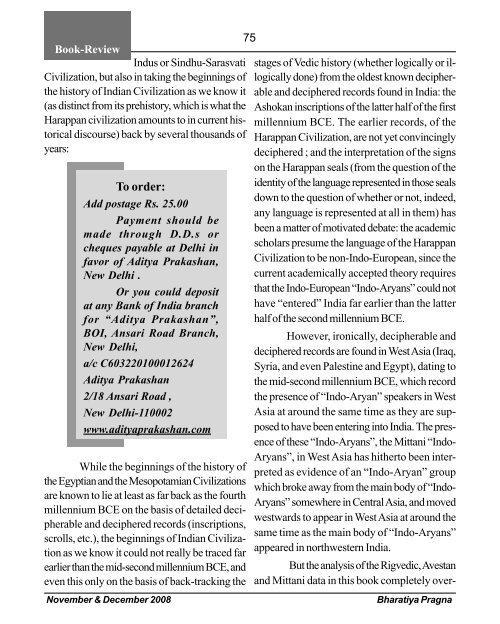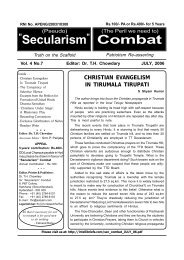Bharatiya Pragna - Dr. Th Chowdary
Bharatiya Pragna - Dr. Th Chowdary
Bharatiya Pragna - Dr. Th Chowdary
You also want an ePaper? Increase the reach of your titles
YUMPU automatically turns print PDFs into web optimized ePapers that Google loves.
Book-Review<br />
Indus or Sindhu-Sarasvati<br />
Civilization, but also in taking the beginnings of<br />
the history of Indian Civilization as we know it<br />
(as distinct from its prehistory, which is what the<br />
Harappan civilization amounts to in current historical<br />
discourse) back by several thousands of<br />
years:<br />
To order:<br />
Add postage Rs. 25.00<br />
Payment should be<br />
made through D.D.s or<br />
cheques payable at Delhi in<br />
favor of Aditya Prakashan,<br />
New Delhi .<br />
Or you could deposit<br />
at any Bank of India branch<br />
for “Aditya Prakashan”,<br />
BOI, Ansari Road Branch,<br />
New Delhi,<br />
a/c C603220100012624<br />
Aditya Prakashan<br />
2/18 Ansari Road ,<br />
New Delhi-110002<br />
www.adityaprakashan.com<br />
While the beginnings of the history of<br />
the Egyptian and the Mesopotamian Civilizations<br />
are known to lie at least as far back as the fourth<br />
millennium BCE on the basis of detailed decipherable<br />
and deciphered records (inscriptions,<br />
scrolls, etc.), the beginnings of Indian Civilization<br />
as we know it could not really be traced far<br />
earlier than the mid-second millennium BCE, and<br />
even this only on the basis of back-tracking the<br />
75<br />
stages of Vedic history (whether logically or illogically<br />
done) from the oldest known decipherable<br />
and deciphered records found in India: the<br />
Ashokan inscriptions of the latter half of the first<br />
millennium BCE. <strong>Th</strong>e earlier records, of the<br />
Harappan Civilization, are not yet convincingly<br />
deciphered ; and the interpretation of the signs<br />
on the Harappan seals (from the question of the<br />
identity of the language represented in those seals<br />
down to the question of whether or not, indeed,<br />
any language is represented at all in them) has<br />
been a matter of motivated debate: the academic<br />
scholars presume the language of the Harappan<br />
Civilization to be non-Indo-European, since the<br />
current academically accepted theory requires<br />
that the Indo-European “Indo-Aryans” could not<br />
have “entered” India far earlier than the latter<br />
half of the second millennium BCE.<br />
However, ironically, decipherable and<br />
deciphered records are found in West Asia (Iraq,<br />
Syria, and even Palestine and Egypt), dating to<br />
the mid-second millennium BCE, which record<br />
the presence of “Indo-Aryan” speakers in West<br />
Asia at around the same time as they are supposed<br />
to have been entering into India. <strong>Th</strong>e presence<br />
of these “Indo-Aryans”, the Mittani “Indo-<br />
Aryans”, in West Asia has hitherto been interpreted<br />
as evidence of an “Indo-Aryan” group<br />
which broke away from the main body of “Indo-<br />
Aryans” somewhere in Central Asia, and moved<br />
westwards to appear in West Asia at around the<br />
same time as the main body of “Indo-Aryans”<br />
appeared in northwestern India.<br />
But the analysis of the Rigvedic, Avestan<br />
and Mittani data in this book completely over-<br />
November & December 2008 <strong>Bharatiya</strong> <strong>Pragna</strong>



